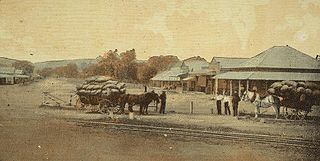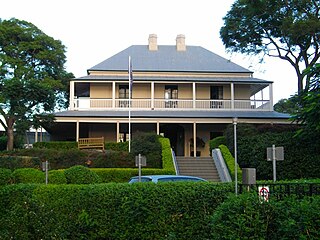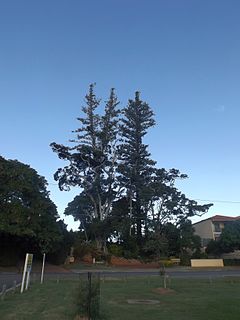
Boonah is a rural town and locality in the Scenic Rim Region, Queensland, Australia. In the 2016 census, Boonah had a population of 2,484 people.

The Old Windmill is a heritage-listed tower mill in Observatory Park adjacent to Wickham Park at 226 Wickham Terrace, Spring Hill, City of Brisbane, Queensland, Australia. It was built in the 1820s by convict labour in the Moreton Bay penal settlement and is the oldest surviving building in Queensland. It is also known as Brisbane Observatory and Windmill Tower. It was added to the Queensland Heritage Register on 21 October 1992. Today it is the centrepiece of Observatory Park.

Helidon is a town and locality in the Lockyer Valley Region of southeast Queensland, Australia. Helidon is located on the Warrego Highway, 106 kilometres (66 mi) west of the state capital, Brisbane, and 21 kilometres (13 mi) east of Toowoomba. The town had a population of 1,059 at the 2016 census.

Glenmore Homestead is a heritage-listed homestead at Belmont Road, Parkhurst, Rockhampton Region, Queensland, Australia. It was built from c. 1858 to c. 1920. The homestead and associated buildings once belonged to pastoral run on the Fitzroy River, seven kilometres northwest of Rockhampton, Queensland. Originally much larger at 127 square miles the current size of the property is 20 acres (8.1 ha). It was added to the Queensland Heritage Register on 21 October 1992.
Arthur Sidney Lyon (1817–1861), was a journalist and newspaper proprietor in Queensland, Australia. He was known as "the father of the press in colonial Queensland". He was the founder of the Moreton Bay Courier and the Darling Downs Gazette.

Mundoolun is a rural locality in the City of Logan, Queensland, Australia. In the 2016 census, Mundoolun had a population of 1,551 people.

The Eton Vale Homestead Ruins are a heritage-listed site on the New England Highway, Cambooya, Toowoomba Region, Queensland, Australia. The former homestead was built from c. 1840 onwards by Arthur Hodgson, and was destroyed by fire in 1912. The site was added to the Queensland Heritage Register on 21 October 1992.

Boonah War Memorial and Memorial Park is a heritage-listed memorial at Park Street, Boonah, Scenic Rim Region, Queensland, Australia. It was built from 1920 to 1922. It was added to the Queensland Heritage Register on 21 October 1992.

Normanby Homestead is a heritage-listed homestead at Cunningham Highway, Warrill View, Queensland, Australia. It was designed by Charles Balding and built from 1866 to 1867. It was added to the Queensland Heritage Register on 21 October 1992.

Wyambyn is a heritage-listed homestead at Tabragalba House Road, Tabragalba, Scenic Rim Region, Queensland, Australia. It was designed in 1908 by Robin Dods and built by Warren and Morgan from 1908 to 1909. It was added to the Queensland Heritage Register on 9 August 2013.

Milton House is a heritage-listed villa at 50 McDougall Street, Milton, City of Brisbane, Queensland, Australia. It was built from c. 1852. It was added to the Queensland Heritage Register on 21 October 1992.

Wolston House is a heritage-listed museum and former homestead at 223 Grindle Road, Wacol, City of Brisbane, Queensland, Australia. It was built from 1852 to 1860s. It was added to the Queensland Heritage Register on 21 October 1992. It is now a historic house museum operated by the National Trust of Queensland.

St John's Church is a heritage-listed Anglican church at Mundoolun Road, Mundoolun, City of Logan, Queensland, Australia. It was designed by John Hingeston Buckeridge and built from 1901 to 1915. It is also known as Memorial Church of St John the Evangelist. It was added to the Queensland Heritage Register on 26 November 1999.

The Norfolk Island Pine Trees are a heritage-listed group of trees at 127 Shore Street North, Cleveland, City of Redland, Queensland, Australia. They were added to the Queensland Heritage Register on 21 November 2003.

Franklyn Vale Homestead is a heritage-listed homestead at Franklin Vale Road, Mount Mort, City of Ipswich, Queensland, Australia. It was built in the early 1870s. It was added to the Queensland Heritage Register on 21 October 1992.

Ipswich & West Moreton Building Society is a heritage-listed building society office at 45 East Street, Ipswich, City of Ipswich, Queensland, Australia. It was designed by Francis Drummond Greville Stanley and built from 1888 to 1950s by Peter Brown. It was added to the Queensland Heritage Register on 21 October 1992.

Kilcoy Homestead is a heritage-listed homestead at Kilcoy-Murgon Road, Winya, Somerset Region, Queensland, Australia. It was built c. 1857. It was added to the Queensland Heritage Register on 21 October 1992.

Burrandowan Station Homestead is a heritage-listed homestead at Kingaroy Road, Durong, South Burnett Region, Queensland, Australia. It was built from 1848 to c. 1927. It was added to the Queensland Heritage Register on 21 October 1992.

Taromeo Station is a pastoral farm off the D'Aguilar Highway, Benarkin, South Burnett Region, Queensland, Australia. It was built from 1854 to the 1860s. It is also contains the Taromeo cemetery. The Taromeo Homestead and its cemetery were added to the Queensland Heritage Register on 21 October 1992.

Coochin is a locality in the Scenic Rim Region, Queensland, Australia. In the 2016 census, Coochin had a population of 96 people.























